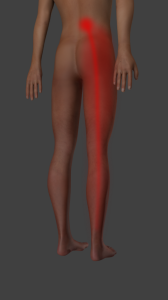The sciatic nerve is located on the end of the spine. The impulses sent through this nerve travel through the spinal area, and into the region of the buttocks. When there is pain experienced from this nerve, it can cause a shooting and sharp pain to occur in the area, and this is known as sciatica. 
Approximately 40 percent of adults will experience sciatic nerve pain at one point throughout their lives. With the right treatment for the condition, the nerve pain can be stopped, as will the many symptoms that accompany it.
Those who experience sciatica receive treatment based on their symptoms, and these can vary from burning, stinging, numbness, and other uncomfortable sensations.
1. OTC Pain Medication
The first method of treatment for those with sciatica is often over-the-counter (OTC) pain medications. A workers compensation pain management doctor will often use this type of treatment in order to stop the pain prior to moving on to stronger treatment method.
The OTC pain medication used varies, and sometimes anti-inflammatory pain medications will be prescribed, while other times medications such as Tylenol will be used to treat the condition.
2. Prescription Pain Medication
If the OTC pain medications are not effective in treating sciatica, the doctor may prescribe a prescription-strength pain medication for pain. This type of medication falls into a class of drugs called narcotics. 
The medication works by stopping the signals of pain from traveling through the body, and then on to the brain. While this treatment is often effective, the physician may deter from this method for long-term use. This is because a tolerance to the medication can build rather quickly, and the patient will need to be prescribed higher doses in order to get results. Also, there is a risk of addiction associated with use of narcotic pain medications.
3. Muscle Relaxers
Muscle relaxers may be prescribed alone, or they can be used along with pain medications in order to treat the sciatica pain. This type of medication works by relaxing the muscles within the body, which can help to stop pressure in the nerve endings, as well as increase the success of the pain relief method used for treating the condition.
There are various types of muscle relaxers, and the physician will be able to determine which is best for each patient. Due to their mechanism of action, muscle relaxers can cause drowsiness to occur, so the patient cannot drive, operate heavy equipment, or perform tasks that require quick reaction time.
4. Epidural Steroid Injections
Epidural steroid injections are an effective treatment method for people experiencing sciatica pain. The shot may be given by a Workers Compensation physician once or twice a month, and it is injected into the spinal area near the sciatic nerve. 
Steroid injections may be used alone, or along with other treatment methods in order to make pain medication more effective. While this treatment method benefits many patients, there are risks associated with long-term use of steroids. These substances can build up in the system and create steroid toxicity, so they are generally only recommended for short-term use.
5. Spinal Decompression Therapy
This is a treatment involving intermittent spinal traction. It was FDA cleared back in the 1990’s and has exponentially gained popularity for the treatment of spinal arthritis, degenerative disc disease and sciatica.
Studies evaluating the effectiveness of spinal decompression therapy for sciatica have shown over an 85% success rate for pain relief.
All in all, over 90% of patients with sciatica are able to avoid the need for surgery. The above treatments may help patients achieve pain relief. Dr. Demitri Adarmes with Arizona IMA is a Double Board Certified workers compensation doctor. Dr. Adarmes helps injured workers from either Arizona or federal workers.






Leave A Comment